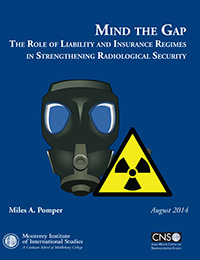
Miles Pomper
August 19, 2014
View the full paper:
Mind the Gap: The Role of Liability and Insurance Regimes in Strengthening Radiological Security
According to a new paper from CNS Senior Research Associate Miles A. Pomper, inadequate liability and insurance regimes mean that users of high-risk radiological sources have insufficient incentive to protect those sources from terrorists or substitute less risky alternatives. Such sources are used in medicine, oil and gas exploration, and industry, among other fields, and can be used in “dirty bombs” or other forms of radiological terrorism.
Since the 9/11 attacks, governments, including the United States, have taken it upon themselves to institute emergency measures to improve source security, often using public funds. However, these measures are less than optimal and are expected to take many more decades. Moreover, even the United States—the lead country in spending on these efforts—routinely sacrifices radiological security to other budget priorities.
Pomper therefore recommends two potential options to improve liability and insurance regimes governing radiological sources in order to incentivize users to reduce the risk of radiological terrorism.
Option One
The clearest and most effective option would be for national authorities, particularly in the United States, to establish that those in legal control of a radiological source are liable for paying damages to victims if there is any untoward radiation release from the source (theft or accident).
Such national legislation would ideally be complimented or brought about by a similar international regime, through, for example, a convention for radiological sources. Such a convention would also clarify other relevant questions about jurisdiction, legal forum, and other relevant aspects of international law. It might also require source manufacturers to include a trace isotope for forensic purposes, and countries to notify the international community if a source fell out of regulatory control. It could also address international repatriation and disposal issues.
Option Two
In the absence of such a regime, countries—in particular on a coordinated, multilateral level—should establish better and clearer rules for radiological security and monitoring provisions (including tracking and tracing technologies) that would allow courts to make a fair judgment about the negligence and liability of those in legal control of sources. Ideally, some kind of international certification program under International Atomic Energy Agency auspices might be developed for this purpose, so that those who met the certification standard or switched to non-isotopic alternatives could profit from lower insurance rates.
In such a scenario, potential victims would still benefit from having coverage against radiological terrorism. In the United States, for example, it would make sense to amend the Terrorism Reinsurance Authorization Act to prohibit excluding radiological terrorism from terrorism insurance policies and bundle the two together in order to assure a greater pool. It would also make sense for the federal government to accept a greater share of the costs of such incidents than those of equivalent conventional terrorist attacks.
In both cases, Pomper argues, it would make sense to use financial assurance tools as a means of insuring against lost or theft of material. That is, in addition to purchasing a bond to pay for disposal, manufacturers, licensees, and shippers should be required to purchase a bond or insurance policy against the risk of loss or control of material before end of life, whenever and wherever it is under their legal control.
